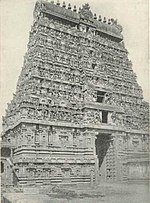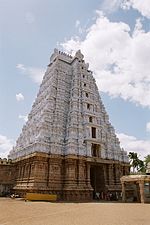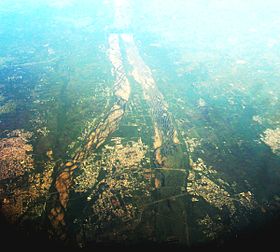Srirangam (Thiruvarangam in Tamil) is an island and a part of the city of Tiruchirappalli, in South India.
Srirangam is bounded by the Kaveri River (also known as Cauvery river) on one side, and the Kaveri distributary Kollidam (Coleroon) on the other side. Srirangam is home to a significant population of Srivaishnavites (followers of Lord Vishnu)
Srirangam is famous for its Sri Ranganathaswamy Temple, a major pilgrimage destination for Hindus (especially Srivaishnavites) and the largest temple complex in India.
According to the temple's website, Srirangam can be considered the biggest functioning Hindu temple in the world, as it covers an area of about 631,000 square metres (6,790,000 sq ft) with a perimeter of 4 km (10,710 ft). Angkor Wat is bigger but non-functioning.
Srirangam among a few "self-manifested" shrines (Swayam Vyakta Kshetras) of Lord Vishnu. The temple complex is enormous and spans 156 acres (0.63 km2). It has seven prakaras or enclosures. These enclosures are formed by thick and huge rampart walls which run round the sanctum. There are 21 magnificent towers in all prakaras providing a unique sight to any visitor. The temple town lies on an islet formed by the twin rivers Cauvery and Coleroon.
The Srirangam temple complex is composed of 7 concentric walled sections and 21 towers gopuram. The southern gopuram of the temple, called the Rajagopuram, is 239.5 feet tall and, as of 2016, is the tallest in Asia. The construction of this Rajagopuram was begun during the reign of Achyuta Deva Raya of the Vijayanagara empire. However, construction was halted after his death and the structure of the rajagopuram remained incomplete for 400 years. The monumental task of completion of the rajagopuram was undertaken and completed successfully by Sri Vedanta Desika Yatheendra Mahadesikan, the 44th jeeyar of Sri Ahobila Matha. The construction was completed in a span of 8 years. The Rajagopuram was consecrated on 25 March 1987.
The temple has seven prakaras (elevated enclosures) with gopurams articulating the axial path, the highest at the outermost prakara and the lowest at the innermost. In historic times, just after the construction of this temple, the city of Srirangam lived completely within the walls of this temple and hence is quoted as an example of Hindu religious utopia – during its peak of existence.
The Srirangam temple is one of the three temples of the God Ranganatha that are situated in the natural islands formed in the Kaveri river. They are:
Clothes such as Silk Sarees, Dhoti, Towels, etc.., used for religious purposes are auctioned here.
Inside the temple complex, there is a separate temple dedicated to the goddess Andal. Additionally, there is a museum, a library and a bookshop.
Srirangam's History got important during the invasion of some jealous Muslim emperors (1310–1311) Srirangam was captured and the riches were looted. The invaders did not want to accept the rituals of Hinduism. They took away the idol of Alagiyamanavalar Perumal and plundered the treasures, jewels and ornaments which belonged to Srirangam temple. The temple idol of Alagiyamanavalar Perumal was sent to Delhi. In Delhi, the idol of Alagiyamanavalar Perumal was taken care of like a devoted mother by the daughter of the Sultan. At the very moment she saw the idol, she fell in love with the deity. She spent all her time with the idol. The Sultan surrendered the statue of Alagiyamanavalar Perumal back to Ramanujacharya. The Daughter of Sultan could not bear this. She is said to have disappeared mysteriously. She now has a separate shrine near the Sriranganatha temple and people worship her. She is called "Thulukka Nachiyar". Even after this incident Srirangam was often attacked and ransacked by various mughal emperors. After the rise of Vijayanagara Kingdom the atrocities of the Mughal Sultans came to an end. King of Vijaya Nagar "Krishna Deva Raya" realized the importance of this sacred city and prioritized Srirangam as equal as Thirupathi and bequeathed a plenty of treasures, jewels and lands to the Srirangam temple. During his period the Srirangam temple was well reformed and many plans were executed for the growth and people welfare and so Srirangam got developed rapidly.
Thiruvarangam is one of the few temples which is always being crowded by devotees.
There are many other famous temples near Srirangam. They include Rockfort temple, Samayapuram Mariamman temple, Tiruvaanaikovil temple, Vayalur Murugan temple, Uraiyur Vekkali Amman temple, Kattu Azhagiya singer temple etc.
In addition along the banks of Kaveri in areas near Srirangam and Tiruchirappalli there are other famous temples of Lord Vishnu most of which house the reclining form of him, namely the Sri Vadivazhagiya Nambi Perumal Temple (Thiru Anbil) and housing the deity Appala Ranganathar, also called the Appukudaththan Temple at Koviladi.
Another temple of Lord Vishnu is at Tiruchirappalli itself, the Azhagiya Nambi Temple at Woraiyur which is part of the Sri Ranganathaswamy Temple at Srirangam.
Srirangam town is also home to several hundred people who work in offices and industries located in Tiruchirappalli. The public transport linking Srirangam to Tiruchirappalli (route #1) is very frequent.
The nearest airport is Tiruchirappalli International Airport.
Trichy Airport has connections to Chennai, Singapore, Dubai, Sharjah, Colombo, Kuala Lumpur.
The Tiruchirappalli fort and Trichy junction which are the distance of 2 km and 8 km serves as connection point to many destinations in southern India, such as Thanjavur, Thiruvananthapuram, Chidambaram, Madurai, Tirupathi, Tuticorin, Tenkasi, Quilon, Rameswaram, Bangalore, Coimbatore, Mysore, Kochi, Kanyakumari and Mangalore. It also connects to western part of Indian cities like Pune, Surat, Ahmedabad, some northern Indian cities like Jodhpur, Bikaner, New Delhi, Jammu.
Trichy Central bus stand has direct services to most parts of Tamil
Nadu. From the bus stand, tourists can avail local buses, taxi, auto
rickshaw to reach Srirangam.
City Bus service to all places of tourist interest from Central Bus Stand and from Chinthamani -Main Guard Gate Bus Stand (Both in Trichy). Tourist Taxis andAuto Rickshaws are also available at reasonable rates.
Route No. 1 of the City bus service runs between Srirangam and Central Bus stand. This route starts from Trichy Central Bus Stand and goes via Trichy Junction Railway Station, Palakkarai Rettai pillaiyar Kovil street, Main Guard Gate, Chatram Bus Stand, Cauvery River Bridge, Mambazha salai, Thiruvanaikkovil and ends at Srirangam Bus Stand near the Srirangam Therkku vaasal (South entrance to the temple).
There is a bus for every 5 minutes and the bus service is round the clock.
Buses TNSTC are originating from Srirangam to various places like Trivandrum, Chennai, Madurai, Kodaikanal, etc.
SOURCES : WIKIPEDIA
Srirangam is bounded by the Kaveri River (also known as Cauvery river) on one side, and the Kaveri distributary Kollidam (Coleroon) on the other side. Srirangam is home to a significant population of Srivaishnavites (followers of Lord Vishnu)
Sri Ranganathaswamy Temple
The main gopuram of Sri Ranganathaswamy Temple, Srirangam
White Gopuram at Srirangam Temple
According to the temple's website, Srirangam can be considered the biggest functioning Hindu temple in the world, as it covers an area of about 631,000 square metres (6,790,000 sq ft) with a perimeter of 4 km (10,710 ft). Angkor Wat is bigger but non-functioning.
Srirangam among a few "self-manifested" shrines (Swayam Vyakta Kshetras) of Lord Vishnu. The temple complex is enormous and spans 156 acres (0.63 km2). It has seven prakaras or enclosures. These enclosures are formed by thick and huge rampart walls which run round the sanctum. There are 21 magnificent towers in all prakaras providing a unique sight to any visitor. The temple town lies on an islet formed by the twin rivers Cauvery and Coleroon.
The Srirangam temple complex is composed of 7 concentric walled sections and 21 towers gopuram. The southern gopuram of the temple, called the Rajagopuram, is 239.5 feet tall and, as of 2016, is the tallest in Asia. The construction of this Rajagopuram was begun during the reign of Achyuta Deva Raya of the Vijayanagara empire. However, construction was halted after his death and the structure of the rajagopuram remained incomplete for 400 years. The monumental task of completion of the rajagopuram was undertaken and completed successfully by Sri Vedanta Desika Yatheendra Mahadesikan, the 44th jeeyar of Sri Ahobila Matha. The construction was completed in a span of 8 years. The Rajagopuram was consecrated on 25 March 1987.
The temple has seven prakaras (elevated enclosures) with gopurams articulating the axial path, the highest at the outermost prakara and the lowest at the innermost. In historic times, just after the construction of this temple, the city of Srirangam lived completely within the walls of this temple and hence is quoted as an example of Hindu religious utopia – during its peak of existence.
The Srirangam temple is one of the three temples of the God Ranganatha that are situated in the natural islands formed in the Kaveri river. They are:
- Adi Ranga: the Ranganathaswamy temple at Srirangapattana
- Madhya Ranga: the Ranganathaswamy temple at Shivanasamudra
- Antya Ranga: the Ranganathaswamy temple at Srirangam
Clothes such as Silk Sarees, Dhoti, Towels, etc.., used for religious purposes are auctioned here.
Inside the temple complex, there is a separate temple dedicated to the goddess Andal. Additionally, there is a museum, a library and a bookshop.
History
Lord Rama performed aradhanam (pooja) to Vishnu's idol (deity in a reclining posture). As a symbol of love he gifted the idol to Vibishana (brother of Ravana of the Hindu epic Ramayana) to take back with him to Lanka. There was a condition that he could not set the idol on earth and if he did it would seat itself permanently. Vibishana took this idol and while travelling towards Lanka, came upon the banks of the river Kaveri. He placed the idol on banks of river Kaveri, while an utsavam was in progress. When the utsavam got over, the Lord refused to move as he loved the place (Srirangam). When Vibhishana requested him to come along with him, the lord refused but promised to bless Vibhishana by always facing South (the direction of Lanka, home to Vibhishana) Hence it is that the deity (in a reclining posture) faces South. Then Chola kings Dharmavarcholan and Killivalavan developed the shrine into the big temple seen now. They built the basic foundations and main buildings.Srirangam's History got important during the invasion of some jealous Muslim emperors (1310–1311) Srirangam was captured and the riches were looted. The invaders did not want to accept the rituals of Hinduism. They took away the idol of Alagiyamanavalar Perumal and plundered the treasures, jewels and ornaments which belonged to Srirangam temple. The temple idol of Alagiyamanavalar Perumal was sent to Delhi. In Delhi, the idol of Alagiyamanavalar Perumal was taken care of like a devoted mother by the daughter of the Sultan. At the very moment she saw the idol, she fell in love with the deity. She spent all her time with the idol. The Sultan surrendered the statue of Alagiyamanavalar Perumal back to Ramanujacharya. The Daughter of Sultan could not bear this. She is said to have disappeared mysteriously. She now has a separate shrine near the Sriranganatha temple and people worship her. She is called "Thulukka Nachiyar". Even after this incident Srirangam was often attacked and ransacked by various mughal emperors. After the rise of Vijayanagara Kingdom the atrocities of the Mughal Sultans came to an end. King of Vijaya Nagar "Krishna Deva Raya" realized the importance of this sacred city and prioritized Srirangam as equal as Thirupathi and bequeathed a plenty of treasures, jewels and lands to the Srirangam temple. During his period the Srirangam temple was well reformed and many plans were executed for the growth and people welfare and so Srirangam got developed rapidly.
Economy
Due to the famous temple, Srirangam has a thriving economy based on tourism. Devotees come from all parts of India and abroad. The number of devotees to the town increases greatly during the festivals like Vaikunta Ekadashi which falls on the Tamil month of Marghazi (Margashirsha).Thiruvarangam is one of the few temples which is always being crowded by devotees.
There are many other famous temples near Srirangam. They include Rockfort temple, Samayapuram Mariamman temple, Tiruvaanaikovil temple, Vayalur Murugan temple, Uraiyur Vekkali Amman temple, Kattu Azhagiya singer temple etc.
In addition along the banks of Kaveri in areas near Srirangam and Tiruchirappalli there are other famous temples of Lord Vishnu most of which house the reclining form of him, namely the Sri Vadivazhagiya Nambi Perumal Temple (Thiru Anbil) and housing the deity Appala Ranganathar, also called the Appukudaththan Temple at Koviladi.
Another temple of Lord Vishnu is at Tiruchirappalli itself, the Azhagiya Nambi Temple at Woraiyur which is part of the Sri Ranganathaswamy Temple at Srirangam.
Srirangam town is also home to several hundred people who work in offices and industries located in Tiruchirappalli. The public transport linking Srirangam to Tiruchirappalli (route #1) is very frequent.
Schools
There are numerous schools, both private and public, in the town. The Higher Secondary School for Boys was founded in 1896 and is the oldest one in the town. There is also a Higher Secondary School for girls which is almost as old as that of the boys. Srimad Andavan College, Chinmaya Vidyalaya Matric. School, Sri Akilandeswari Vidyalaya, Sri Ranga Matriculation School, Sri Vaijayanthi Vidhyalaya, Srivageesha vidhyashram etc., are other institutions in Srirangam. Most of the schools have English as a medium of instruction. Some have Tamil as a medium of instruction, and some have both. There are many school children who travel to nearby Trichy also.Transport
Air
Srirangam as seen from the air
Trichy Airport has connections to Chennai, Singapore, Dubai, Sharjah, Colombo, Kuala Lumpur.
Rail
Srirangam has a railway station that can be reached from Chennai through any of the major trains travelling in the Chennai-Kanyakumari railway track and the approximate journey time from Chennai is about 5 hours and 10 minutes (320 km). Only selected trains stops at Srirangam and rest at Tiruchirappalli junction.The Tiruchirappalli fort and Trichy junction which are the distance of 2 km and 8 km serves as connection point to many destinations in southern India, such as Thanjavur, Thiruvananthapuram, Chidambaram, Madurai, Tirupathi, Tuticorin, Tenkasi, Quilon, Rameswaram, Bangalore, Coimbatore, Mysore, Kochi, Kanyakumari and Mangalore. It also connects to western part of Indian cities like Pune, Surat, Ahmedabad, some northern Indian cities like Jodhpur, Bikaner, New Delhi, Jammu.
Bus
Bridge Connecting Trichy and Srirangam across Kaveri River
City Bus service to all places of tourist interest from Central Bus Stand and from Chinthamani -Main Guard Gate Bus Stand (Both in Trichy). Tourist Taxis andAuto Rickshaws are also available at reasonable rates.
Route No. 1 of the City bus service runs between Srirangam and Central Bus stand. This route starts from Trichy Central Bus Stand and goes via Trichy Junction Railway Station, Palakkarai Rettai pillaiyar Kovil street, Main Guard Gate, Chatram Bus Stand, Cauvery River Bridge, Mambazha salai, Thiruvanaikkovil and ends at Srirangam Bus Stand near the Srirangam Therkku vaasal (South entrance to the temple).
There is a bus for every 5 minutes and the bus service is round the clock.
Buses TNSTC are originating from Srirangam to various places like Trivandrum, Chennai, Madurai, Kodaikanal, etc.
Climate
The climate of Trichy (and Srirangam) is Tropical. Average Temperature Range (°C): Summer- Max. 37.1 °C (98.8 °F) Min. 26.4 °C (79.5 °F); Winter- Max. 31.3 °C (88.3 °F) Min. 20.6 °C (69.1 °F); Rainfall: 835 millimetres (32.9 in)POSTED BY : VIPUL KOULSOURCES : WIKIPEDIA





No comments:
Post a Comment